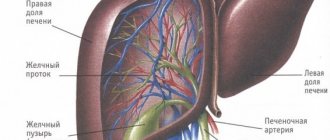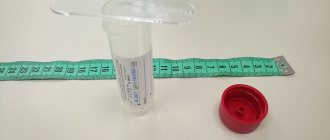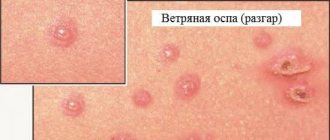Treatment of phlegmon
Treatment of phlegmon is surgical - opening the abscess, excision of necrotic tissue (see photo below).
In the photo, the phlegmon is opened, the Achilles tendon is visible at the bottom of the wound.
After opening the abscess, the wound is cleaned, inflammation subsides, and wound healing processes begin.
In the photo, the wound has cleared and is beginning to heal.
In the complex treatment of phlegmon, antibiotics, immunocorrectors, physiotherapy, etc. are also used.
The photo below shows phlegmon of the left forearm, which developed from a boil.
In the photo below, the same phlegmon is opened, the wound is cleaned.
The photo below shows the same wound, almost healed.
The wound has healed.
The photo below shows advanced phlegmon of the thigh. The duration of the disease is 2 weeks.
The patient refused hospitalization, so treatment of phlegmon had to be carried out in a clinic. In the photo below - the same phlegmon 7 days after the operation - the wound has cleared and is granulating.
After cleaning the wound, secondary sutures were applied (photo below).
Symptoms of phlebitis
In acute and chronic phlebitis of the superficial veins, the inflamed vein is tense and painful. The skin on the leg is tight, hot and red. Red stripes appear along the vein.
With acute and chronic phlebitis of the deep veins, the patient's temperature rises. The skin over the damaged area becomes thin and red. A red stripe appears along the inflamed vessel. The limb swells and hurts. The patient feels weak in the body.
Cerebral phlebitis is an inflammation of blood vessels leading to the destruction of venous walls. Characterized by weakness, high blood pressure, dizziness, prolonged and frequent headaches. The inflamed area becomes numb.
Pylephlebitis is a purulent inflammatory process in the veins. The disease is indicated by: weakness, prolonged fatigue, fever with chills, abdominal pain, vomiting, headache, poor appetite and insomnia. The symptoms are similar to a cold. Sometimes pylephlebitis provokes bleeding from the stomach or intestines. Therefore, if you feel that the symptoms are not typical of a cold, then contact a phlebologist for an examination.
Abscess
Unlike phlegmon, an abscess is an accumulation of pus separated from other tissues. In essence, an abscess is a localized phlegmon.
In the photo - in the upper outer quadrant of the left gluteal region - there is a painful swelling with redness of the skin. 10 days ago, injections were given in this place - post-injection abscess of the left gluteal region.
In the photo above, against the background of existing callus, pain, redness of the skin, swelling arose, the epidermis was partially exfoliated with pus - a subcallosal abscess.
Article “Post-injection complications in the work of a nurse”
Post-injection complications
Infiltrate
- the most common complication after subcutaneous and intramuscular injections - is considered as a nosocomial infection.
Most often, infiltration occurs if: a) the injection is performed with a blunt needle; b) for intramuscular injection, a short needle intended for intradermal or subcutaneous injections is used. Some drugs, when administered intramuscularly with a short needle, cause severe chemical irritation of tissues and are absorbed for a long time, which together leads to the formation of infiltrates. Inaccurate choice of injection site, frequent injections into the same place, violation of aseptic rules are also the cause of infiltrates. Infiltration is characterized by the formation of a compaction at the injection site, which is easily determined by palpation (feeling).
Abscess
- purulent inflammation of soft tissues with the formation of a cavity filled with pus and delimited from surrounding tissues by a pyogenic membrane.
The reasons for the formation of an abscess are the same as for infiltrates. With infiltration and abscess, soft tissue becomes infected as a result of violation of asepsis rules. These complications belong to the group of nosocomial infections.
Needle breakage
during injection is possible when using old, worn needles, as well as when there is a sharp contraction of the buttock muscles during an intramuscular injection, if a psychoprophylactic conversation is not held with the patient before the injection or the injection is given to the patient in a standing position.
Drug embolism
(Greek Embolia - throwing in) can occur when injecting oil solutions subcutaneously or intramuscularly (oil solutions are not injected intravenously!) and the needle gets into the vessel. Oil, once in the artery, will clog it and this will lead to disruption of the nutrition of surrounding tissues and their necrosis. Signs of necrosis: increasing pain in the injection area, swelling, redness or red-bluish discoloration of the skin, increased local and general temperature. If the oil ends up in a vein, it will enter the pulmonary vessels through the bloodstream. Symptoms of pulmonary embolism: a sudden attack of suffocation, cough, blue discoloration of the upper half of the body (cyanosis), a feeling of tightness in the chest.
1
Air embolism
with intravenous injections and infusions it is the same dangerous complication as oil. The signs of air embolism are the same as oil embolism, but they appear very quickly (within a minute), since the cubital vein is large and anatomically located close to the pulmonary vessels.
Incorrect administration of a drug
should also be considered as a complication of the injection. In such cases, a 0.9 percent sodium chloride solution, a total of 50-80 ml, should be immediately injected into the injection site and around it. This will reduce the concentration of the erroneously administered drug and reduce its irritating effect on the tissue. For this purpose, you can place an ice pack at the injection site.
The antagonist of an erroneously administered drug can be administered only as prescribed by a doctor.
If the drug is administered (erroneously) subcutaneously, then before administering an isotonic sodium chloride solution, a tourniquet should be applied above the injection site (this will slow down the absorption of the drug).
Damage to nerve trunks
can occur with intramuscular and intravenous injections, either mechanically (if the injection site is chosen incorrectly), or chemically, when the drug depot is near the nerve (with intravenous injection, part of the drug may end up under the skin), as well as when the vessel supplying the nerve is blocked . The severity of the complication can vary - from neuritis (inflammation of the nerve) to paralysis (loss of function) of the limb.
Thrombophlebitis
- inflammation of a vein with the formation of a blood clot in it - observed with frequent venipunctures of the same vein, or when using insufficiently sharp needles. Signs of thrombophlebitis are pain, skin hyperemia and the formation of infiltrate along the vein. Body temperature may be low-grade.
Necrosis
(death) of tissue can develop when venipuncture is unsuccessful and a significant amount of an irritating agent is mistakenly introduced under the skin. Penetration of the drug under the skin during venipuncture is possible due to:
- piercing the vein “through and through”;
- failure to enter the vein initially.
2
Most often this happens with inept intravenous administration of a 10% calcium chloride solution. If the solution does get under the skin, you should act in the same way as if you administered the drug by mistake, only in this case an ice pack is not applied, since a 10% calcium chloride solution is dangerous only due to its local irritant effect, and not its resorptive effect.
Hematoma
(hemorrhage under the skin) can also occur during inept venipuncture: a purple spot appears under the skin, as the needle pierced both walls of the vein and blood penetrated into the tissue. In this case, the puncture of this vein should be stopped and pressed for several minutes with cotton wool (napkin) and alcohol. In this case, the intravenous injection prescribed to the patient is given into another vein, and a local warming (semi-alcohol) compress is placed on the area of the hematoma.
Sepsis
(generalized form of infection) can occur due to gross violations of aseptic rules during intravenous injection or infusion, as well as when using non-sterile solutions. Sepsis also belongs to the group of nosocomial infections.
Long-term complications that occur 2-4 months after the injection include viral hepatitis B, D, non-A, non-B (serum hepatitis), C, D - an infectious disease whose incubation period lasts 2-6 months, as well as HIV infection, in which the incubation period ranges from 6-12 weeks to several months. These complications are nosocomial infections.
Allergic reactions
to the administration of a particular drug by injection can occur in the form of urticaria, acute runny nose, acute conjunctivitis, Quincke's edema. The most dangerous form of an allergic reaction is anaphylactic shock.
When some drugs are administered intravenously, a local allergic reaction is observed. If the patient develops an allergic reaction, the doctor must be immediately informed and emergency care must be started.
Anaphylactic shock develops within a few seconds or minutes from the moment the drug is administered. The faster the shock develops, the worse the prognosis. The lightning-fast course of shock ends in death. Most often, anaphylactic shock is characterized by the following sequence of symptoms: general redness of the skin, rash, coughing attacks, severe anxiety, irregular breathing, decreased blood pressure, and arrhythmia of the heartbeat.
3
Symptoms can appear in various combinations. Death usually occurs from acute respiratory failure due to bronchospasm and pulmonary edema, acute cardiovascular failure.
***************
Post-injection complications
attracted the attention of doctors more than a hundred years ago, immediately after the invention of the syringe in 1853 and the first injections in 1855.
The widespread introduction of disposable syringes into medical practice has greatly facilitated and simplified the procedure for intramuscular and subcutaneous injections. However, the frequency of post-injection complications and their treatment still remain one of the pressing problems.
Modern medicine is unthinkable without the use of a large number of injections. Thus, according to a number of researchers, in Russia over 1 million injections are performed daily for the purpose of treatment, immunization and diagnostic studies. In parallel with the increase in the number of injections, the number of post-injection complications also increases.
Considering the frequency of the disease, its gradual increase, the involvement of medical workers in the occurrence of post-injection complications and the unsatisfactory results of treatment of this pathology, attention should be paid to the causes of post-injection complications: where, by whom and when injections performed most often lead to complications, which medications are more often complicated by abscesses and phlegmons ; what is the mechanism of development of the pathological process; what methods can be used to clarify the diagnosis of post-injection complications; which treatment method will be optimal when choosing treatment in each specific case.
Post-injection complications
1) Pyrogenic reactions .
Accompanied by a sharp rise in temperature and stunning chills. This happens when using drugs that have expired, or introducing poorly prepared solutions;
4
2) Fat embolism of the pulmonary vessels.
Occurs when drugs intended for internal or subcutaneous administration, such as a solution of camphor in oil, are mistakenly administered into a vein. Fat embolism is manifested by sudden pain in the heart area, choking, coughing, blueness of the face, upper half of the chest;
3) Air embolism of pulmonary vessels.
It occurs when air bubbles that are not promptly removed from the syringe or blood transfusion systems enter;
4) Dizziness, collapse, heart rhythm disturbance.
May be a consequence of too rapid administration of the drug;
5) Infiltration.
Formed when the drug enters the subcutaneous tissue. This occurs in the case of through perforation of the vein. Getting drugs such as euphyllia and calcium chloride under the skin is very painful. If this happens, it is recommended to place a semi-alcohol or dry compress on the elbow area;
6) Hematoma.
It is more often formed in patients with impaired blood clotting or increased vascular permeability. Prevention of this complication is long-term (3-5 minutes) and firm pressure on the site and injection;
7) Sepsis.
It can develop when the rules of eseptic and antiseptic conditions are violated;
 Phlebitis.
Phlebitis.
Inflammation of a vein caused by chemical or physical irritation is often accompanied by thrombosis of the affected vessel;
9) Allergic reactions.
May occur with most medications. They manifest themselves in the form of skin itching, skin rashes, and Quincke's edema. The most dangerous form of an allergic reaction is anaphylactic shock (shortness of breath, nausea, itchy skin, decreased blood pressure, loss of consciousness, bluish skin). If the patient develops any of these symptoms, you should immediately stop administering the medication and immediately provide emergency assistance. Anaphylactic shock develops within a few seconds or minutes from the moment the drug is administered. The faster the shock develops, the worse the prognosis. The main symptoms of anaphylactic shock: a feeling of heat in the body, a feeling of tightness in the chest, suffocation, dizziness, headache, anxiety, severe weakness, decreased blood pressure, heart rhythm disturbances. In severe cases, these signs are accompanied by symptoms of collapse, and death can occur a few minutes after the first symptoms of anaphylactic shock appear. Treatment for anaphylactic shock should be carried out immediately upon detection of a feeling of heat in the body.
5
Long-term complications that occur two to four months after the injection are viral hepatitis B, D, C, as well as HIV infection;
10) Abscess
- purulent inflammation of soft tissues with the formation of a cavity filled with pus. The reasons for the formation of abscesses are the same as for infiltrates. In this case, infection of soft tissues occurs as a result of violation of asepsis rules.
11) Damage to nerve trunks
can occur with intramuscular and intravenous injections, either mechanically (if the injection site is chosen incorrectly), or chemically, when the drug depot is located next to the nerve, as well as when the vessel supplying the nerve is blocked. The severity of the complication can vary - from neuritis to paralysis of a limb.
12) Thrombophlebitis
- inflammation of a vein with the formation of a blood clot in it - observed with frequent venipunctures of the same vein, or when using blunt needles. Signs of thrombophlebitis are pain, skin hyperemia and the formation of infiltrate along the vein. The temperature may be low-grade.
13) Necrosis
tissue can develop due to unsuccessful vein puncture and erroneous injection of a significant amount of irritating agent under the skin. Ingress of drugs along the course of venipuncture is possible due to: piercing the vein “through and through”; failure to enter the vein initially. Most often this happens with inept intravenous administration of a 10% calcium chloride solution. If the solution does get under the skin, you should immediately apply a tourniquet above the injection site, then inject a 0.9% sodium chloride solution into the injection site and around it, a total of 50-80 ml (it will reduce the concentration of the drug).
Conclusion
If sanitary and epidemiological requirements for performing medical procedures are violated, an artificial mechanism of infection transmission may be triggered. Any of the invasive procedures can lead to infection. A special place among various hospital infections is occupied by post-injection complications due to the high frequency of injection interventions. Here's what you need to do to have fewer post-injection complications:
The nurse must be careful not to mix up the medications, make a good injection (for example, accurately hit the vein);
- Ensuring high-quality disinfection and sterilization of consumables, medical products used for injections, catheterization;
6
Strict adherence to antisepsis and asepsis when carrying out parenteral manipulations;
Compliance with the technique of hygienic washing and hygienic antisepsis of the hands of medical personnel in treatment rooms, vaccination rooms, and those performing parenteral injection procedures;
Antiseptic treatment of the patient's skin before injection;
Compliance with the sanitary and anti-epidemic regime in treatment rooms, vaccination rooms, and manipulation rooms. Carrying out production and laboratory control in treatment rooms, vaccination rooms, and manipulation rooms.
7
Atheroma
A type of abscess - suppurating atheroma - video of an operation to open an abscess
At the stage of abscess formation, there is still the possibility of conservative treatment (antibiotics, physiotherapy, semi-alcohol dressings), which often results in cure. If a cavity with pus has formed, the only treatment is surgery. Under anesthesia or local anesthesia, the abscess is opened, pus flows out, after which the dead tissue is excised as completely as possible, the wound is washed and drained. After the operation, dressings are required (daily or every other day). The wound healing period is 10 - 20 days (depending on the size, depth and other factors. With extensive phlegmon, skin grafting may be required.
How to treat bumps on the buttocks
Regardless of the reason for which you have painful lumps after injections, they still need to be treated. “You definitely shouldn’t self-medicate, especially with “fresh” infiltrates, since any infiltrate can both resolve and fester. I’ll immediately explain what a “fresh” infiltrate is. This is a lump that you discovered immediately after the injection or is not older than 14 days. If the infiltrate is 1-2 months or more old, then the probability of its suppuration is quite small, but the probability of its complete resorption also tends to zero,” notes the specialist.
If it doesn’t reach the point of an abscess, then you can get by with fairly simple means - using gels, ointments and compresses. “What specific medication you need, the frequency and duration of its use, is determined by the doctor during an in-person visit after examination and carrying out the necessary examination methods (ultrasound of soft tissues),” says the doctor.
At home, hematomas and infiltrates can be treated with safe means. “Moderate massaging of the injection site, performing squats and applying cold compresses to the site of swelling in the first 1-2 days after its appearance is acceptable,” reminds Bulat Yunusov.
“Bumps after injections can be treated with an iodine mesh, but it is better to see a surgeon so that he can prescribe physical therapy,” the general practitioner recommends.
Physiotherapy is prescribed as an addition to the main treatment, which allows it to be shortened. Among the most effective methods are:
- Electrophoresis
is the penetration of medicinal drugs into the skin and soft tissues under the influence of an electric field. - UHF.
“This is the treatment of infiltration with a continuous or pulsed ultra-high-frequency electric field,” comments a doctor at a Moscow clinic. - Phototherapy.
Irradiation of problem areas with ultraviolet light in a narrow or wide range.
Inflammatory infiltrate
This group of pathologies is divided into several types. Inflammatory infiltrate - what is it? The medical encyclopedia explains everything, which talks about the ways in which inflammation occurs and indicates the reasons for the appearance of pathological tissue reactions.
Medicine identifies a large number of varieties of infiltrates of the subgroup under consideration. Their presence may indicate problems with the immune system, congenital diseases, the presence of acute inflammation, chronic infectious disease, allergic reactions in the body.
The most common type of this pathological process is inflammatory infiltrate. What it is, helps to understand the description of the characteristic features of this phenomenon. So, what should you pay attention to? Tissue compaction in the area of inflammation. Painful sensations occur when pressed. With stronger pressure, a hole remains on the body, which levels out slowly, since the displaced cells of the infiltrate return to their original place only after a certain period of time.
What is infiltration?
INFILTRATE - The release of some parts of blood through the walls of blood vessels into the surrounding tissue. Dictionary of foreign words included in the Russian language. Chudinov A.N., 1910. INFILTRATE, the release of some parts of the blood (lymph, white bodies) through the walls of blood vessels into ... Dictionary of foreign words of the Russian language
INFILTRATE - (from Latin in in and filtratus strained) local compaction and increase in tissue volume due to the accumulation of blood in them (during inflammation), tumor cells (tumor infiltrate), etc. ... Big Encyclopedic Dictionary
infiltrate - a, m. infiltrat m., German. Infiltrat <lat. Local compaction and increase in tissue volume due to the accumulation of red blood cells, leukocytes, neoplasm cells, etc. ALS 1. <On the left leg> infiltrates began to appear in the tissue, ... ... Historical Dictionary of Gallicisms of the Russian Language
INFILTRATE - INFILTRATE, infiltrate, male. (biol., med.). Infiltration product, formation in tissue due to infiltration. Ushakov's explanatory dictionary. D.N. Ushakov. 1935 1940 ... Ushakov's Explanatory Dictionary
Infiltrate is one of the components of inflammation, representing a place of accumulation of cellular elements of the lymphoid and macrophage systems in response to the action of damaging infectious factors. and non-infectious, exogenous and endogenous nature. Based on cellular composition they distinguish... ... Dictionary of Microbiology
infiltrate - noun, number of synonyms: 1 • accumulation (75) ASIS Dictionary of Synonyms. V.N. Trishin. 2013 ... Dictionary of synonyms
infiltrate - a; m. Biol., med. Accumulation in the tissues of the body of cellular elements mixed with blood and lymph due to the inflammatory process. Inflammatory and Formation of infiltrate. * * * infiltrate (from Latin in in and filtratus strained), local... ... Encyclopedic Dictionary
infiltrate - infiltratas statusas T sritis ekologija ir aplinkotyra apibrėžtis Iš kitur prasiskverbusi, prasisunkusi medžiaga. atitikmenys: engl. infiltrate vok. Infiltrat, n rus. infiltration, m … Ekologijos terminų aiškinamasis žodynas
infiltrate - infiltratas statusas T sritis ekologija ir aplinkotyra apibrėžtis Įsiskverbusių į audinį ląstelių elementų ir kitų medžiagų visuma. atitikmenys: engl. infiltrate vok. Infiltrat, n rus. infiltration, m … Ekologijos terminų aiškinamasis žodynas
infiltrate - (infiltratus; in + lat. filtro, filtratum filter) an area of tissue characterized by the accumulation of cellular elements usually not characteristic of it, increased volume and increased density; sometimes the term I. is used to designate the area ... ... Big Medical Dictionary
Source: https://dic.academic.ru/dic.nsf/ruwiki/193173
The meaning of the word "infiltration"
INFILTRATE
, -a,
m. Biol., med.
Accumulation in the tissues of the body of cellular elements mixed with blood and lymph due to the inflammatory process.
Inflammatory infiltrate.
Source (printed version):
Dictionary of the Russian language: In 4 volumes / RAS, Institute of Linguistics.
research; Ed. A. P. Evgenieva. — 4th ed., erased. - M.: Rus. language; Polygraph resources, 1999; (electronic version):
Fundamental electronic library
- Infiltrate (from Latin in - in; filtratus - strained) is an accumulation of cellular elements mixed with blood and lymph in the tissues of the body. The most common are inflammatory and tumor infiltrate. The inflammatory infiltrate consists predominantly of polymorphonuclear leukocytes (purulent infiltrate), erythrocytes (hemorrhagic infiltrate), lymphoid cells (round cell infiltrate), histiocytes and plasma cells (histiocytic-plasma cell infiltrate), etc. Such infiltrates can resolve, melt, undergo sclerosis, with the formation cavities, abscess, scar, etc. Tumor infiltrate consists of tumor cells of various nature (cancer, sarcoma) and is a manifestation of infiltrating tumor growth. With the formation of infiltrate, the tissue increases in volume, changes color, becomes denser, and sometimes becomes painful. In surgical practice, infiltration is a compaction that occurs in tissues when they are saturated with an anesthetic (pain-relieving) solution (see Local novocaine blockade).
Infiltrate (infiltratus) is an area of living tissue characterized by the presence of cellular elements usually not characteristic of it, increased volume and increased density; sometimes the term infiltrate is used by physicians to refer to an area of tissue infiltrated by some artificially administered substance (for example, alcohol, antibiotic, anesthetic solution).
INFILTRATE
, a,
m.
(biol., med.). Infiltration product, formation in tissue due to infiltration.
Source:
“Explanatory Dictionary of the Russian Language” edited by D. N. Ushakov (1935-1940);
(electronic version):
Fundamental electronic library
Making the Word Map better together
Hello! My name is Lampobot, I am a computer program that helps you make Word Maps. I can count perfectly, but I still don’t understand very well how your world works. Help me figure it out!
Thank you!
I will definitely learn to distinguish widely used words from highly specialized ones.
How clear is the meaning of the word Oberführer
(noun):
Source: https://kartaslov.ru/%D0%B7%D0%BD%D0%B0%D1%87%D0%B5%D0%BD%D0%B8%D0% B5-%D1%81%D0%BB%D0%BE%D0%B2%D0%B0/%D0%B8%D0%BD%D1%84%D0%B8%D0%BB%D1%8C%D1% 82%D1%80%D0%B0%D1%82
Reasons for appearance
The likelihood of infiltration occurring is equally present in people of any age.
The results of the study showed that the cause of the disease can be various types of injuries and infectious diseases. They can be transmitted by contact and have a lymphogenous type of spread.
An infiltrate very often develops in the tissues of the perimaxillary region. What it is? How to distinguish it from other diseases? Only an experienced doctor can assess the patient’s condition and give an accurate answer to the questions posed. The causative agents of inflammation are staphylococci, streptococci and other representatives of the microflora of the oral cavity.
A complicated condition of acute appendicitis can also cause the development of infiltrate. It occurs due to untimely surgical intervention.









